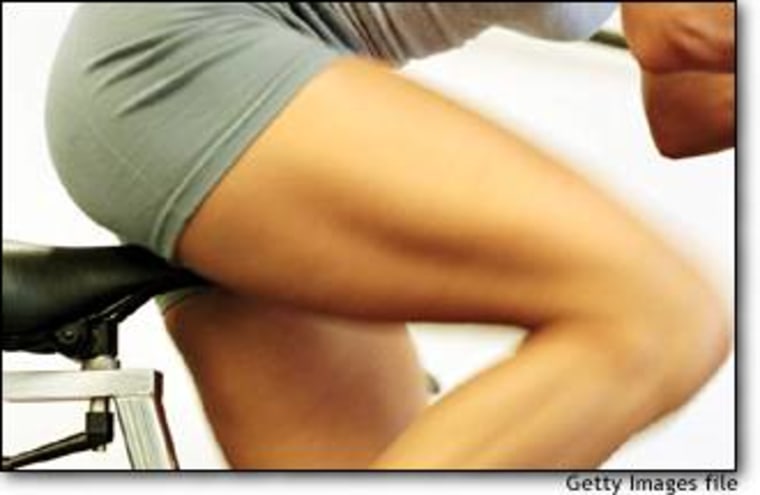What’s the best way to fight cellulite? Is it O.K. to eat before a workout? Smart Fitness answers your queries. Have an exercise question? Send to smartfitness@msnbc.com. We’ll post selected answers in future columns.
Question: Seems like all of my female friends complain of cellulite. How can exercise help us get rid of it?
Answer: You and your friends may take small comfort in knowing you’re among the vast majority of women who experience the dreaded dimpling of cellulite. While it’s known to affect some men, cellulite is infamous for plaguing women with the “cottage-cheese” or “orange-peel” effect on the thighs, hips and buttocks. It’s most obvious in these areas because that’s where fat tends to accumulate in women.
And while doctors say cellulite is just that — ordinary fat — the term is widely used to describe the lumpy skin appearance that can result from a combination of factors: too much fat, too little muscle, thinning skin and connective tissue beneath the skin that separates fat cells into pockets.
Exercise can reduce cellulite
Exercise can help minimize cellulite by burning off fat and building muscle, says Wayne Westcott, fitness research director at the South Shore YMCA in Quincy, Mass. Because fat is very soft tissue, it doesn’t keep the legs looking firm, smooth and shapely like muscle does.
Physical fitness is particularly important in fighting cellulite as women age, he says, because each decade they lose about 5 pounds of muscle and gain 15 pounds of fat.
“You have this shrinking foundation under this growing fat layer, and eventually the fat clumps,” Westcott explains. “It’s not just a matter of having too much fat. It’s a combination of too much fat and too little muscle.”
Strength training key
While many women diet and engage in fat-burning aerobic exercise to combat cellulite, they may not realize the importance of strength training, notes Westcott, author of the new book “No More Cellulite” (Perigee, 2003), co-authored with colleague Rita La Rosa Loud.
Dieting in the absence of strength training can actually promote the appearance of cellulite by causing muscle loss, he says, so lifting weights to build and maintain muscle is key.
In his own research, Westcott found that sedentary women who modified their diet and engaged in 45-minute sessions of aerobic exercise, weight training and stretching (see sidebar) three times a week saw results within two months.
“About 70 percent of the women had major changes and were very pleased,” he says. These women said they had “a lot less cellulite” after completing the program, while the remaining participants said they had “less cellulite.”
“Overall, they gained about 1.5 pounds of muscle, lost about 9 pounds of fat and increased strength by 46 percent,” says Westcott. “They also lost just under 2 inches off their hip measurements.”
Len Kravitz, coordinator of exercise science at the University of New Mexico in Albuquerque, agrees that exercise can have a big impact on cellulite. “Minimizing bodily fat while enhancing muscle firmness, especially in the legs, is the best approach,” he says, and a variety of workout regimens can help.
Unfortunately, there isn’t a permanent quick-fix for cellulite, according to Kravitz: “There are no magic cures, pills, creams or ‘silver bullets’ out there for cellulite reduction.”
Question: Should I eat before or after exercise? And what are the best foods to consume?
Answer: It’s OK to eat certain foods before and after exercise, experts say, but don’t overdo it, especially just prior to a workout.
Exercising after consuming a heavy meal is not advisable because it can interfere with proper digestion, says Richard Cotton, a San Diego-based spokesperson for the American Council on Exercise, a nonprofit fitness watchdog group.
“When you’re exercising and digesting there’s a battle in your body for oxygen, and usually the working muscles win out,” says Cotton, who is also the chief exercise physiologist for MyExercisePlan.com, a virtual personal training site. “That can lead to an upset stomach, cramp or a stitch.”
Don't go hungry during workouts
At the same time, though, don’t embark on a workout if your stomach is growling. Your body needs fuel for the activity. Some quick carbohydrates from a piece of fruit or an energy bar can do the trick, Cotton says. The same goes for early-morning workouts — make sure to eat something light like a piece of whole-grain toast and some fruit juice.
After exercise, allow your body time to cool down before eating. Then be sure to include some carbs in your next snack or meal. “The carbohydrates are necessary to replace glucose used during the exercise session and especially glycogen (carbohydrate) stores in the muscle,” says Kara Mitchell, an exercise physiologist and dietitian with the Duke Health and Fitness Center in Durham, N.C.
Of course, getting plenty of water is paramount, so drink up — 8 ounces — before and after exercise. And while you’re working up a sweat, be sure to get at least 4 ounces every 15 minutes.
